Are you ready to embrace sustainability and be a part of the rise of dark green house?
In this article, we will explore the concept of dark green houses and how they are revolutionizing sustainable living.
Dark green houses go beyond traditional methods of eco-friendly design by incorporating innovative technologies and strategies that significantly reduce their environmental impact.
Imagine living in a home that not only provides comfort and security but also actively contributes to a healthier planet.
Dark green houses make this dream a reality by prioritizing energy efficiency, renewable resources, and minimal carbon emissions.
With their cutting-edge designs, these sustainable homes harness natural light, optimize insulation, and utilize advanced systems for water conservation and waste management.
By embracing dark green houses, you can play an active role in reducing your carbon footprint while enjoying all the benefits of modern living.
So let’s delve into the world of dark green houses together and discover how they are shaping the future of sustainable architecture.
Introduction
In this discussion, you’ll explore the concept of dark green houses and their significance in sustainable architecture.
Dark green houses are defined as innovative structures that prioritize eco-friendly design principles and energy efficiency. It’s crucial to embrace sustainable architecture in order to minimize our ecological footprint and contribute to a more environmentally friendly future.
Dark green houses represent an exciting approach towards achieving this goal.
Definition of Dark Green House
Contrary to popular belief, a Dark Green House isn’t just an eco-friendly building, but rather a living organism that actively contributes to the environment’s well-being. It generates over 90% of its energy needs from renewable sources. This type of house goes beyond sustainability; it aims to harmonize with nature while providing a comfortable and efficient living space.
Imagine walking up to a dark green house in the middle of a lush green landscape, surrounded by towering trees and vibrant flowers. The dark green siding house blends seamlessly into its surroundings, appearing as if it’s grown naturally from the earth itself.
Inside the dark green house, you’re greeted by an abundance of natural light filtering through large windows strategically placed to maximize solar gain. The air feels fresh and invigorating, thanks to state-of-the-art ventilation systems that continuously circulate clean air throughout the house.
As you explore further, you notice rainwater collection systems that provide water for irrigation and non-potable uses, reducing reliance on municipal water supplies. Additionally, the roof is adorned with solar panels that harness the power of sunlight to generate electricity for all your daily needs.
Transitioning into the subsequent section about the importance of sustainable architecture, it becomes evident that dark green houses are not only aesthetically pleasing but also crucial in addressing our planet’s pressing environmental challenges.
Importance of Sustainable Architecture
Step into a world where architecture becomes a catalyst for positive change, where innovative design choices and eco-conscious materials create homes that nurture the environment and your well-being. Sustainable architecture goes beyond just creating aesthetically pleasing structures; it aims to minimize the negative impact on the planet while maximizing energy efficiency and promoting healthier living spaces. By embracing sustainable architecture, we can revolutionize the way we live, reducing our carbon footprint and creating a more harmonious relationship with nature.
To better understand the importance of sustainable architecture, let’s take a closer look at how it incorporates eco-friendly design principles and energy efficiency. Imagine a three-column table in your mind. In the first column, you have design choices such as utilizing natural ventilation, optimizing daylighting, and incorporating green roofs or walls. These choices not only enhance the aesthetic appeal of a home but also reduce reliance on artificial lighting and air conditioning systems, ultimately decreasing energy consumption. The second column represents eco-conscious materials like reclaimed wood, recycled metals, low VOC paints, and renewable energy sources such as solar panels or geothermal heating systems.
These materials ensure that construction processes are environmentally friendly while also providing long-term benefits in terms of durability and minimal maintenance requirements. Lastly, in the third column lies the positive outcomes: reduced greenhouse gas emissions, lower utility bills due to increased energy efficiency, improved indoor air quality promoting better health for occupants, and an overall sense of responsibility towards preserving our planet.
Dark green houses represent an innovative approach to sustainable living by combining these eco-friendly design principles with energy efficiency measures. They offer not only beautiful architectural designs but also serve as symbols of our commitment to safeguarding our environment for future generations.
Thesis statement
Dark green houses represent an innovative approach to sustainable living, combining eco-friendly design principles and energy efficiency.
Imagine stepping into a world where architecture harmonizes with nature, creating homes that are not only visually stunning but also actively contribute to a sustainable future. This is the essence of dark green houses, an innovative approach to sustainable living.
Dark green houses embrace eco-friendly design principles and prioritize energy efficiency, making them a promising solution for addressing environmental concerns. By integrating elements such as solar panels, rainwater harvesting systems, and natural ventilation techniques, these houses minimize their ecological footprint while providing comfortable living spaces.
The concept of dark green houses goes beyond just being environmentally friendly; it strives to create a symbiotic relationship between humans and nature, where both can thrive together.
Dark green houses represent a significant shift in architectural practices toward sustainability. These homes are designed to maximize energy conservation through passive solar heating and cooling methods. Strategic placement of windows allows for optimal natural light and ventilation, reducing the need for artificial lighting or air conditioning. Additionally, dark green houses often incorporate high-quality insulation materials and efficient appliances to further minimize energy consumption.
Transitioning into the subsequent section about ‘the concept of dark green houses,’ one can’t help but be intrigued by how this innovative approach redefines traditional notions of home construction.
The Concept of Dark Green Houses
So, you want to know more about the concept of dark green houses.
Well, understanding this concept involves recognizing its key elements and design principles.
These houses are built with sustainability in mind, incorporating features like energy efficiency, use of renewable materials, and passive heating and cooling systems.
Understanding the “Dark Green” Concept
Are you ready to discover the revolutionary concept of ‘Dark Green’ houses and how they’re transforming the way we think about sustainability?
Dark green houses take sustainable living to a whole new level by incorporating innovative design elements and technologies that minimize their environmental impact. These houses not only prioritize energy efficiency but also aim to create a harmonious relationship between the built environment and nature. With dark green houses, you can enjoy a home that not only meets your needs but also supports the health of our planet.
To understand the ‘dark green’ concept, it’s important to recognize its key principles. First and foremost, these houses focus on reducing energy consumption through efficient insulation, smart lighting systems, and renewable energy sources like solar panels. They also emphasize water conservation by utilizing rainwater harvesting systems and low-flow fixtures.
Additionally, dark green houses prioritize materials that have a minimal carbon footprint during production and offer longevity for reduced waste generation. By integrating all these elements into their design, dark green houses are paving the way for sustainable living without compromising comfort or style.
So let’s delve into the key elements of dark green house design next!
Key Elements of Dark Green House Design
If you want to embrace sustainability in your home design, there are several key elements you should consider.
First, focus on incorporating passive solar design features that harness the sun’s energy for heating and lighting.
Second, choose sustainable building materials that minimize environmental impact and promote energy efficiency.
Lastly, prioritize efficient insulation and ventilation systems to reduce energy waste and ensure a comfortable living environment.
Additionally, integrating renewable energy sources like solar panels can further enhance the sustainability of your dark green house design.
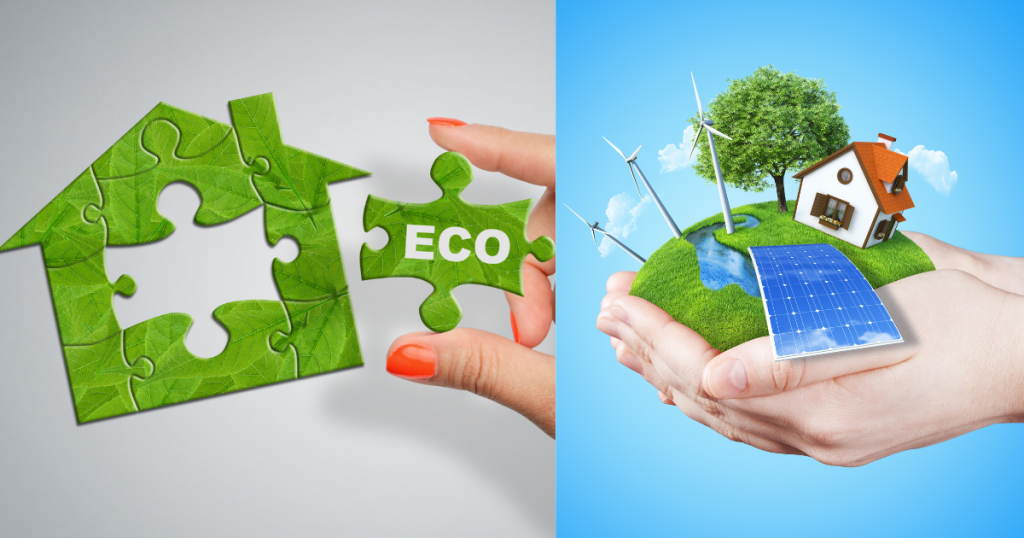
Passive Solar Design
To fully embrace passive solar design, you should consider incorporating elements such as large south-facing windows and thermal mass materials to effectively harness and store solar energy.
By having large south-facing windows, you allow maximum sunlight into your home, which helps warm up the space during colder months.
Additionally, using thermal mass materials such as concrete or stone can absorb and retain the heat from the sun, releasing it slowly throughout the day and keeping your home warm even after sunset.
This strategic design allows you to reduce reliance on traditional heating systems and lower your carbon footprint.
Now that you understand how passive solar design can optimize energy use in your dark green house, let’s explore sustainable building materials for a truly eco-friendly construction approach.
Sustainable Building Materials
Let’s now explore sustainable building materials that can enhance the eco-friendliness of your construction project and make it even more enjoyable to build.
When it comes to choosing materials for your dark green house, opt for those that have a minimal impact on the environment throughout their life cycle. Consider using recycled materials such as reclaimed wood or salvaged bricks, which not only reduce waste but also add character to your home.
Another great option is bamboo, known for its fast growth and durability. It can be used for flooring, cabinetry, and even structural elements. Additionally, look for products with low VOC (volatile organic compound) emissions to improve indoor air quality.
By selecting sustainable building materials, you’re taking a significant step towards creating an environmentally friendly home that promotes a healthier lifestyle.
Now let’s move on to efficient insulation and ventilation techniques without compromising on sustainability.
Efficient Insulation and Ventilation
One key aspect of creating an eco-friendly home is ensuring efficient insulation and ventilation, which can be as refreshing as a breath of fresh air. To help you understand the importance of this subtopic, here are three benefits of efficient insulation and ventilation in dark green houses:
- Improved energy efficiency: Proper insulation helps to keep your home at a comfortable temperature year-round, reducing the need for excessive heating or cooling. This not only saves you money on energy bills but also reduces your carbon footprint.
- Enhanced indoor air quality: Effective ventilation systems ensure that stale air is constantly replaced with fresh outdoor air, promoting better indoor air quality. This helps to reduce allergens, pollutants, and moisture buildup, creating a healthier living environment for you and your family.
- Increased comfort and well-being: With efficient insulation and ventilation, you can enjoy consistent temperatures throughout your home without any cold drafts or hot spots. This creates a more comfortable space where you can relax and unwind.
Now that you understand the importance of efficient insulation and ventilation in eco-friendly homes, let’s explore the next step: renewable energy integration.
Renewable Energy Integration
Get ready to harness the power of renewable energy and take your eco-friendly home to the next level by integrating sustainable energy sources. Renewable energy integration is a crucial aspect of creating dark green houses that are not only efficient but also environmentally friendly. By incorporating solar panels, wind turbines, or geothermal systems into your home’s design, you can significantly reduce your reliance on traditional energy sources and minimize your carbon footprint. Imagine the satisfaction of knowing that your house is powered by clean, renewable energy while contributing to a more sustainable future. As you explore the benefits of dark green houses in the subsequent section, you’ll discover how this integration plays a vital role in achieving long-term environmental and economic advantages without compromising comfort or style.
Benefits of Dark Green Houses
In a discussion about the benefits of dark green houses, two key points to consider are reduced environmental impact and enhanced energy efficiency.
By utilizing sustainable building practices and materials, dark green houses minimize their carbon footprint and contribute to a healthier planet.
Additionally, these houses are designed with energy-efficient features such as insulation, solar panels, and smart technology, resulting in lower energy consumption and utility bills for homeowners.
Reduced Environmental Impact
In this discussion, we’ll explore the concept of reduced environmental impact in relation to embracing sustainability.
One key point is the lower carbon footprint associated with dark green houses. They’re designed to minimize energy consumption and emissions.
Additionally, we’ll delve into the importance of water conservation in these houses. They often incorporate innovative systems for collecting and reusing water resources.
Lower Carbon Footprint
You can significantly reduce your carbon footprint by choosing to live in a dark green house, where your impact on the environment will be as small as a drop in the ocean.
Dark green houses are designed to minimize energy consumption and maximize energy efficiency, resulting in lower greenhouse gas emissions. These houses utilize renewable energy sources such as solar panels and geothermal systems, reducing reliance on fossil fuels. Additionally, dark green houses are built with sustainable materials that have low embodied carbon, further decreasing their environmental impact.
By making this choice, you not only contribute to a healthier planet but also enjoy long-term cost savings through reduced energy bills.
Transitioning into the subsequent section about water conservation, you will find that dark green houses also prioritize efficient water usage without compromising comfort or convenience.
Water Conservation
Imagine living in a home that effortlessly reduces water waste, allowing you to enjoy a comfortable and convenient lifestyle while being mindful of the planet’s precious resources. Dark green houses are at the forefront of embracing sustainability, not only by lowering their carbon footprint but also through effective water conservation strategies. These innovative homes employ various techniques and technologies to minimize water usage without compromising on comfort. A key aspect of water conservation in dark green houses is the implementation of efficient plumbing fixtures and appliances.
By installing low-flow toilets, faucets, and showerheads, these homes significantly reduce water consumption while still providing adequate functionality. Additionally, rainwater harvesting systems play a crucial role in capturing and storing rainwater for non-potable uses such as irrigation or toilet flushing. Another strategy employed by dark green houses is the use of graywater systems, which treat wastewater from sinks, showers, and washing machines for reuse in landscaping or toilet flushing purposes. These sustainable practices not only save gallons of freshwater but also contribute to reducing strain on municipal water supplies and wastewater treatment facilities. Transitioning into ‘enhanced energy efficiency,’ dark green houses go beyond just conserving water; they also focus on optimizing energy consumption to further reduce their environmental impact.
Enhanced Energy Efficiency
In this discussion, we’ll explore the subtopic of enhanced energy efficiency. You’ll learn about two key points: lower energy consumption and cost savings on utilities.
By implementing energy-efficient practices in your home, you can reduce your overall energy usage and save money on monthly utility bills.
Lower Energy Consumption
By significantly reducing energy consumption, dark green houses are paving the way for a more sustainable future. These innovative houses utilize various strategies to lower their energy usage, such as incorporating high-performance insulation, efficient appliances, and smart home technologies.
The use of natural light is maximized through strategically placed windows and skylights, reducing the need for artificial lighting during the day. Additionally, dark green houses often employ renewable energy sources like solar panels to further minimize their reliance on traditional power grids.
With these measures in place, homeowners can enjoy lower electricity bills while contributing to environmental conservation. Transitioning into the subsequent section about ‘cost savings on utilities’, these energy-efficient homes not only benefit the planet but also provide significant financial advantages for their inhabitants.
Cost Savings on Utilities
You can significantly reduce your monthly utility bills by implementing energy-saving measures in your home, such as using high-performance insulation and efficient appliances. Can you picture how much money you could save if you minimized your reliance on traditional power grids and utilized renewable energy sources like solar panels?
Not only will you be contributing to a more sustainable future, but you’ll also enjoy the financial benefits of lower energy costs. By embracing dark green house design, which includes incorporating passive heating and cooling techniques, optimizing natural lighting, and utilizing rainwater harvesting systems, you can further enhance your cost savings while creating a more environmentally friendly living space.
Implementing Dark Green House Design
When implementing dark green house design, you’ll need to collaborate with architects and designers who are experienced in sustainable building practices. They can help you create a design that maximizes energy efficiency and minimizes environmental impact.
You should also focus on choosing sustainable materials for construction, such as recycled or locally sourced materials, to further reduce your carbon footprint.
Additionally, integrating renewable energy sources like solar panels or wind turbines is crucial for achieving a truly sustainable home.
Lastly, consider the role of smart home technology in energy management, as it can help monitor and control energy usage to optimize efficiency and reduce waste.
Collaboration with Architects and Designers
Architects and designers play a pivotal role in creating sustainable homes that inspire and excite. They have the expertise to design houses that are not only aesthetically pleasing but also environmentally friendly. By collaborating with architects and designers, homeowners can ensure that their dark green houses are designed to maximize energy efficiency, reduce waste, and minimize environmental impact.
One way architects and designers contribute to sustainable house design is by incorporating passive solar design principles. This involves strategically placing windows, using shading devices, and optimizing insulation to take advantage of natural sunlight and heat. By harnessing these natural resources effectively, homeowners can reduce their reliance on artificial lighting and heating systems, thus reducing energy consumption.
Additionally, architects and designers can integrate rainwater harvesting systems into their designs, allowing homeowners to collect and reuse rainwater for various purposes such as irrigation or flushing toilets.
By working closely with architects and designers who specialize in sustainable design practices, homeowners can create dark green houses that are not only visually appealing but also eco-friendly. Once the house is designed with sustainability in mind, the next step is choosing sustainable materials that align with these principles without compromising on quality or style.
Choosing Sustainable Materials
When it comes to choosing sustainable materials for your construction projects, there are two key points to consider:
- Opt for eco-friendly construction products. This can reduce the negative impact on the environment while still achieving a high level of quality and durability.
- Use recycled or reclaimed materials. Not only does this help conserve natural resources, but it also adds a unique aesthetic appeal to your project.
Eco-friendly Construction Products
Sustainable construction products are revolutionizing the way houses are built, making it easier than ever to create eco-friendly homes. These innovative products not only help reduce the environmental impact of construction but also provide a healthier living environment for homeowners. By incorporating materials that are renewable, recyclable, and low in embodied energy, builders can significantly decrease their carbon footprint. For example, bamboo flooring is an excellent alternative to hardwood as it grows quickly and can be harvested sustainably. Additionally, using recycled steel for framing structures reduces the need for new mining and extraction processes while still providing structural integrity. Furthermore, insulation made from recycled denim or cellulose fibers offers both thermal efficiency and soundproofing capabilities. To give you a visual representation of these eco-friendly construction products, take a look at the table below:
| Sustainable Construction Products | Benefits |
|---|---|
| Bamboo Flooring | Renewable resource; low embodied energy |
| Recycled Steel Framing | Reduces mining and extraction; durable material |
| Recycled Denim Insulation | Thermal efficiency; soundproofing |
With such exciting options available in sustainable construction products, it is now easier than ever to build greener homes that have minimal impact on the environment while maximizing comfort and efficiency. In the next section, we will explore how utilizing recycled and reclaimed materials can further enhance sustainability in house construction without compromising style or functionality.
Recycled and Reclaimed Materials
You can make a positive impact on the environment by incorporating recycled and reclaimed materials into your home construction. This creates a unique and heartfelt space that tells a story. By choosing to use recycled wood, you not only reduce deforestation but also give new life to old materials with character and history.
Reclaimed bricks can add charm and authenticity to your home while reducing waste in landfills. Incorporating salvaged metal or glass into your design not only adds an artistic touch but also reduces the need for energy-intensive manufacturing processes.
Using recycled and reclaimed materials allows you to build sustainably while adding a personal touch to your space. Transitioning into the subsequent section about integrating renewable energy sources, you can further enhance the sustainability of your home by harnessing natural resources such as solar or wind power.
Integrating Renewable Energy Sources
When it comes to integrating renewable energy sources into your home, there are a few key options to consider.
One option is installing solar panels and solar water heaters, which can harness the power of the sun to generate electricity and heat water.
Another option is incorporating wind turbines, which can capture wind energy and convert it into usable electricity.
By embracing these technologies, you can not only reduce your reliance on traditional energy sources but also contribute to a more sustainable future.
Solar Panels and Solar Water Heaters
By harnessing the power of solar energy through the use of panels and heaters, you can significantly reduce your carbon footprint. Solar panels convert sunlight into electricity, allowing you to power your home with clean and renewable energy.
With solar water heaters, you can heat your water using the sun’s energy instead of relying on fossil fuels. This not only helps to lower your utility bills but also reduces greenhouse gas emissions.
Additionally, installing solar panels and heaters can increase the value of your property.
Now let’s move on to another sustainable energy source: wind turbines.
Wind Turbines
Wind turbines, also known as windmills, spin gracefully in the breeze, converting the kinetic energy of the wind into electricity. These towering structures are becoming increasingly popular in dark green houses as a sustainable source of power. By harnessing the power of nature, wind turbines offer an environmentally friendly alternative to traditional energy sources. As the wind blows, it propels the turbine blades, which then turn a generator to produce electricity. The amount of electricity generated depends on factors such as wind speed and turbine size. To give you an idea of their efficiency, let’s take a look at this table:
| Wind Speed (mph) | Power Output (kW) |
|---|---|
| 5 | 0 |
| 10 | 2 |
| 15 | 8 |
| 20 | 18 |
As you can see from the table above, higher wind speeds result in greater power output from the turbine. This renewable energy source not only reduces greenhouse gas emissions but also lowers dependence on fossil fuels. Transitioning smoothly into our next topic about ‘the role of smart home technology in energy management,’ we can explore how these technologies complement and optimize the use of wind turbines for sustainable living without compromising comfort or convenience.
The Role of Smart Home Technology in Energy Management
With the help of smart home technology, you can effortlessly weave energy management into the fabric of your daily life, like a symphony conductor seamlessly orchestrating each instrument.
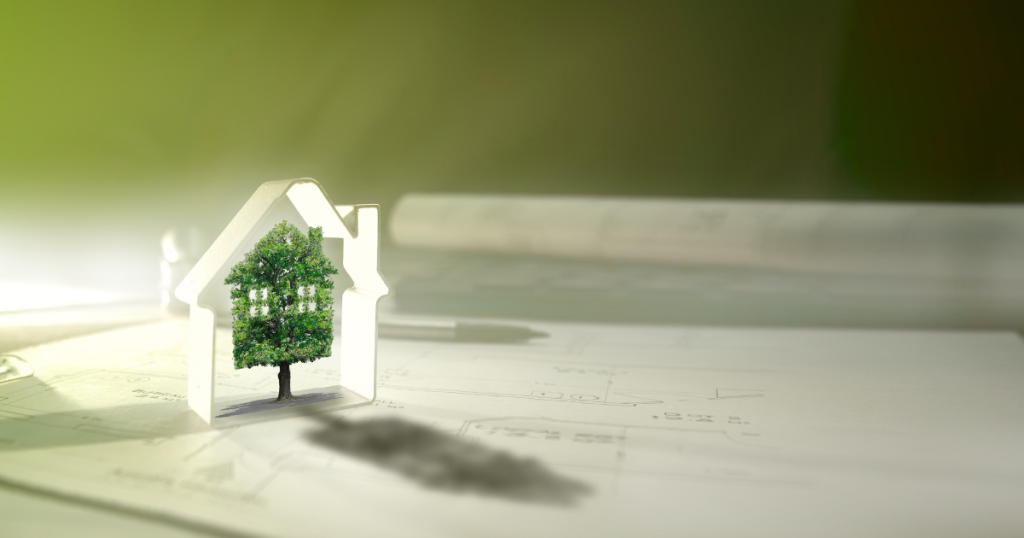
Smart home devices such as thermostats, lighting controls, and power outlets allow homeowners to monitor and control their energy consumption with ease. For example, you can program your smart thermostat to adjust the temperature based on your schedule or remotely turn off lights and appliances when not in use. These small but impactful actions can lead to significant energy savings over time.
In addition to making energy management more convenient, smart home technology also provides valuable insights into energy usage patterns. By analyzing data collected from various devices throughout the house, you can identify areas where energy is being wasted and make informed decisions on how to optimize efficiency. This knowledge empowers you to take proactive steps toward reducing your carbon footprint while still enjoying a comfortable living environment.
With these innovative tools at your disposal, embracing sustainability becomes second nature – a seamless integration into your everyday routine.
Transitioning now into case studies: exemplary dark green houses, we will explore real-life examples of how homeowners have successfully incorporated smart home technology into their sustainable living practices without compromising on comfort or style.
Case Studies: Exemplary Dark Green Houses
In this discussion, you will explore two exemplary dark green houses: ‘Eco Haven’, a net-zero energy residence, and ‘The Sustainable Retreat’, a home designed to live in harmony with nature.
Both of these houses showcase innovative sustainable design features and practices that make them stand out as examples of environmentally friendly living.
From their use of renewable energy sources to their integration with the natural landscape, these case studies demonstrate how dark green houses can be both beautiful and eco-friendly.
“Eco Haven”: A Net-Zero Energy Residence
In this discussion, we’ll explore the design features and innovations of ‘Eco Haven’, a net-zero energy residence that embraces sustainability.
You’ll discover how this house incorporates cutting-edge technologies and architectural elements to reduce its environmental impact.
Additionally, we’ll delve into the process of conducting an environmental impact assessment for ‘Eco Haven’ to understand its overall ecological footprint.
Design Features and Innovations
Consider incorporating design features and innovations into your dark green house to maximize its sustainability and environmental impact. Start by installing solar panels on the roof, which will generate clean energy for your home and reduce your reliance on fossil fuels.
Implement smart home technology that allows you to monitor and control energy usage, optimizing efficiency throughout the day.
Use sustainable building materials such as bamboo or reclaimed wood for construction, reducing the carbon footprint of your house.
Install rainwater harvesting systems to collect and reuse water for irrigation or toilet flushing, conserving this valuable resource.
Finally, incorporate passive design strategies like natural ventilation and shading to minimize the need for artificial cooling and heating.
By incorporating these design features and innovations into your dark green house, you can create a truly sustainable living space that positively impacts both the environment and your daily life.
Transitioning into the next section about ‘environmental impact assessment’, it’s important to evaluate how these design choices contribute to overall sustainability goals.
Environmental Impact Assessment
To fully understand the effects of your sustainable design choices, you’ll need to conduct an environmental impact assessment. This assessment will provide valuable insights into the long-term implications of your decisions. By analyzing various aspects such as energy consumption, water usage, waste management, and carbon emissions, you can identify areas for improvement. This will help you make informed decisions to minimize your project’s ecological footprint. Understanding how your design choices impact the environment is crucial in creating a truly sustainable retreat. It is where living in harmony with nature becomes a reality.
“The Sustainable Retreat”: Living in Harmony with Nature
In this discussion, we’ll explore the key points of the Subtopic: ‘The Sustainable Retreat’: Living in Harmony with Nature.’ You’ll learn about the emphasis on Biophilic Design, which focuses on incorporating nature into architectural design.
Additionally, we’ll delve into the community impact of sustainable retreats and how they can inspire and educate others about living in harmony with nature.
Emphasis on Biophilic Design
With an emphasis on biophilic design, dark green houses are transforming the way we connect with nature and create sustainable living spaces. These innovative homes prioritize a deep connection to the natural world, incorporating elements such as large windows to let in natural light, indoor gardens that purify the air, and living walls covered in lush vegetation.
The benefits of biophilic design are numerous: it improves air quality, reduces stress levels, increases productivity, and enhances overall well-being. By bringing nature into our homes in such a tangible way, dark green houses inspire us to live more sustainably and appreciate the beauty of our surroundings.
Transitioning into community impact and education is crucial to ensure that this movement continues to grow and make a lasting difference in our society’s relationship with the environment.
Community Impact and Education
Ironically, it seems that our connection to nature and sustainable living is best fostered when we step outside the confines of traditional homes. Dark green houses not only prioritize eco-friendly practices, but they also have a profound impact on the surrounding community and promote education about sustainability.
These houses serve as living examples of how individuals can make a positive difference in their environment by utilizing renewable energy sources, implementing water conservation methods, and incorporating natural materials into their design. By showcasing these principles in action, dark green houses inspire others to adopt similar practices and create a ripple effect of change within the community.
Furthermore, these houses often offer educational programs and workshops that aim to educate people about sustainable living techniques and raise awareness about environmental issues. Through this focus on community impact and education, dark green houses empower individuals to take an active role in preserving our planet for future generations.
Transitioning into the subsequent section about ‘overcoming challenges in dark green house construction’, it becomes evident that despite their numerous benefits, building such environmentally friendly structures does come with its own set of hurdles.
Overcoming Challenges in Dark Green House Construction
When it comes to building dark green houses, you may face a few challenges.
First, there’s the initial cost and investment, as these sustainable homes often require higher upfront expenses.
Additionally, finding sustainable materials can be a challenge due to their limited availability in some areas.
Lastly, navigating building regulations and permits can be tricky when it comes to incorporating innovative and eco-friendly features into your home design.
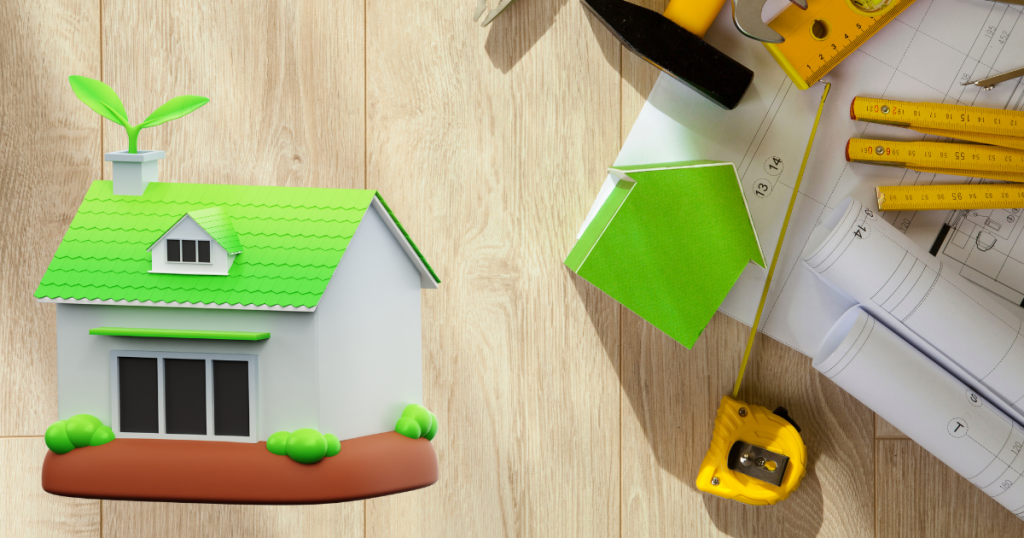
Initial Cost and Investment
Contrary to popular belief, the initial cost of investing in dark green houses is well worth it for long-term savings and sustainability. While it’s true that constructing a dark green house may require a higher upfront investment compared to traditional construction methods, the benefits far outweigh the initial expenses.
Dark green houses are designed with energy efficiency in mind, utilizing sustainable materials and advanced technologies that significantly reduce energy consumption. This means lower utility bills over time, resulting in substantial savings that can offset the initial cost of building such a house.
Moreover, dark green houses have longer lifespans compared to conventional homes. The use of durable materials and high-quality construction techniques ensures that these houses stand the test of time. With proper maintenance and care, a dark green house can last for generations without significant deterioration or the need for major repairs. This longevity translates into more savings over the years as you minimize expenses on renovations or rebuilding.
Transitioning into the subsequent section about the limited availability of sustainable materials, it’s important to note that while investing in a dark green house may bring long-term benefits, one challenge faced by builders is the limited availability of sustainable materials necessary for its construction.
Limited Availability of Sustainable Materials
To build a sustainable home, you’ll need to be aware of the limited availability of materials that are environmentally friendly. While there’s a growing demand for sustainable materials, their production and distribution are still limited.
This means that finding these materials may require some extra effort and research on your part. You may have to search for suppliers who specialize in eco-friendly products or explore alternative options such as reclaimed or recycled materials.
To help you navigate this challenge, here are some important points to keep in mind:
- Look for local suppliers: Locating nearby suppliers can reduce transportation costs and carbon emissions associated with long-distance shipping.
- Consider alternative materials: Instead of traditional building materials like concrete and steel, explore options like bamboo, straw bales, or rammed earth. These alternatives often have lower environmental impacts.
- Embrace creativity: Sustainable homes often involve innovative designs and construction methods. Don’t be afraid to think outside the box and experiment with unconventional yet eco-friendly materials.
By being proactive in sourcing sustainable materials, you can contribute to the rise of dark green houses while also making a positive impact on the environment.
Now let’s move on to discussing how you can navigate building regulations and permits smoothly without encountering any major obstacles.
Now that we have discussed the limited availability of sustainable materials for building dark green houses, let’s explore another challenge: navigating building regulations and permits. When it comes to constructing environmentally friendly homes, there are often stringent rules and regulations that must be followed. These regulations can vary from one location to another, making it difficult for homeowners and builders to navigate the process.
To ensure compliance with building codes and permits, it is important to understand the specific requirements in your area. This may involve conducting research or consulting with professionals who are knowledgeable about sustainable construction practices. Additionally, you may need to obtain permits for specific features or systems that are unique to dark green houses, such as solar panels or rainwater harvesting systems. Navigating these regulations can be time-consuming and require additional paperwork and documentation.
| Challenges | Solutions | Benefits |
|---|---|---|
| Stringent rules and regulations | Conduct research or consult professionals familiar with sustainable construction practices | Ensures compliance with codes and permits |
| Obtaining permits for unique features/systems | Complete necessary paperwork/documentation | Allows incorporation of environmentally friendly features |
As you navigate through the complexities of building regulations and permits, remember that these guidelines are in place to promote safety, sustainability, and efficiency in construction projects. While they may add an extra layer of complexity to the process, complying with these requirements will ultimately contribute towards creating a more sustainable living environment. With a clear understanding of the rules in your area and proper documentation on hand, you will be well-equipped to move forward in your journey towards constructing a dark green house.
Transitioning into the subsequent section about ‘inspiring change: the future of dark green houses’, it is crucial to recognize how overcoming challenges like limited availability of sustainable materials and navigating building regulations lays a solid foundation for driving innovation in sustainable housing design.
Inspiring Change: The Future of Dark Green Houses
Are you curious about the future of dark green houses? Well, get ready to be inspired!
The growing popularity and awareness surrounding sustainable living has paved the way for an exciting future in dark green house construction. With advancements in sustainable technologies, such as solar panels and energy-efficient systems, these houses are becoming more accessible and affordable.
Plus, with government support and incentives for green construction, there’s never been a better time to embrace the future of dark green houses.
Growing Popularity and Awareness
Despite the challenges, society is increasingly recognizing the importance of dark green houses and their positive impact on the environment. Here are three reasons why this concept is gaining popularity:
1) Reduced carbon footprint: Dark green houses utilize sustainable materials and energy-efficient technologies, resulting in significantly lower carbon emissions compared to traditional houses. By embracing these eco-friendly practices, homeowners can contribute to mitigating climate change and preserving the planet for future generations.
2) Cost savings: Dark green houses are designed to be highly energy-efficient, which translates into lower utility bills for homeowners. With features such as solar panels, rainwater harvesting systems, and advanced insulation techniques, these houses help reduce electricity consumption and water waste. This not only benefits the environment but also provides significant long-term savings for homeowners.
3) Healthier living spaces: Dark green houses prioritize indoor air quality by using non-toxic building materials and implementing effective ventilation systems. These measures create a healthier living environment by reducing exposure to harmful chemicals commonly found in conventional homes. Additionally, natural light optimization techniques promote better mental health and productivity among occupants.
As society becomes more conscious of its environmental impact and seeks sustainable solutions, dark green houses have emerged as a promising option that addresses both ecological concerns and individual needs. Transitioning now to advancements in sustainable technologies…
Advancements in Sustainable Technologies
With innovative eco-friendly solutions, you can experience a harmonious blend of modern technology and nature’s embrace, creating sustainable living spaces that inspire awe.
Advancements in sustainable technologies have revolutionized the way we build houses, making it easier than ever to reduce our environmental impact without sacrificing comfort or style. From solar panels that generate clean energy to smart home systems that optimize energy usage, these technologies allow homeowners to live in harmony with the planet while enjoying all the modern conveniences.
One of the most exciting advancements is the development of efficient insulation materials that minimize heat loss and reduce energy consumption. These materials not only keep your home cozy during winter but also help lower your utility bills.
Additionally, water-saving fixtures such as low-flow toilets and rainwater harvesting systems are becoming increasingly popular, allowing homeowners to conserve this precious resource. With all these innovations at your fingertips, you can create a sustainable living space that not only benefits the environment but also enhances your quality of life.
Transitioning into the subsequent section about government support and incentives for green construction, it’s clear that embracing sustainability is not only rewarding on a personal level but also supported by external factors aiming for a greener future.
Government Support and Incentives for Green Construction
You can take advantage of government support and incentives to make your sustainable home construction dreams a reality.
Governments around the world are recognizing the importance of promoting green construction and are offering various programs to support homeowners in their efforts.
One common incentive is tax credits for energy-efficient upgrades such as solar panels, energy-efficient appliances, or insulation. These tax credits can significantly reduce the cost of these upgrades, making them more affordable and enticing for homeowners.
In addition to tax credits, some governments also offer grants or financial assistance specifically targeted at sustainable home construction. These grants can help cover a portion of the costs associated with building a green home, such as purchasing environmentally friendly materials or implementing renewable energy systems.
By taking advantage of these government programs, you not only save money but also contribute to a more sustainable future by reducing your carbon footprint. So why wait? Start exploring the government support and incentives available in your area and turn your vision of a dark green house into a reality today!
Frequently Asked Questions
How much does it cost to build a dark green house?
Building a dark green house can be expensive, but the long-term benefits outweigh the initial cost. Prices vary depending on size and location, ranging from $200,000 to over $1 million.
What are some common misconceptions about dark green houses?
Some common misconceptions about dark green houses include the belief that they are expensive to build and maintain, that they are only suitable for warm climates, and that they lack aesthetic appeal.
Are there any government incentives or tax credits available for building a dark green house?
Yes, there are government incentives and tax credits available for building a dark green house. You can save both money and the environment by taking advantage of these programs.
Can dark green houses be retrofitted into existing homes?
Yes, dark green houses can be retrofitted into existing homes. You can update your home with energy-efficient appliances, insulation, and renewable energy sources to reduce your carbon footprint and save money on utilities.
How can homeowners maintain the energy efficiency of a dark green house over time?
To maintain the energy efficiency of your dark green house over time, remember the adage “prevention is better than cure.”Regularly check insulation, seals, and appliances for any leaks or inefficiencies to save on energy costs.
Conclusion
In conclusion, you’ve now gained a deeper understanding of the concept of dark green houses and the benefits they bring to both individuals and the environment.
By embracing sustainability and implementing innovative design strategies, these houses are paving the way for a greener future.
Imagine this: within the next decade, it’s estimated that dark green houses will reduce carbon emissions by a staggering 50%. Just picture it – neighborhoods filled with homes that not only provide comfort and security but also actively contribute to mitigating climate change.
With their energy-efficient features, such as solar panels and rainwater harvesting systems, these houses become beacons of sustainability. They stand as a testament to our commitment to creating a better world for future generations.
As we look ahead, it’s clear that dark green houses hold immense potential in revolutionizing the way we live. Through case studies of exemplary projects, we’ve seen how architects and builders have overcome challenges to create sustainable homes that are both aesthetically pleasing and environmentally responsible.
The future holds even greater promise as more individuals recognize the importance of embracing sustainable practices in their own lives.
So why not join this movement? Whether you’re considering building your dream home or simply looking to make your current residence more eco-friendly, embracing dark green house principles can make a significant impact.
Together, let’s take steps towards creating a sustainable future where every home becomes an agent of positive change.
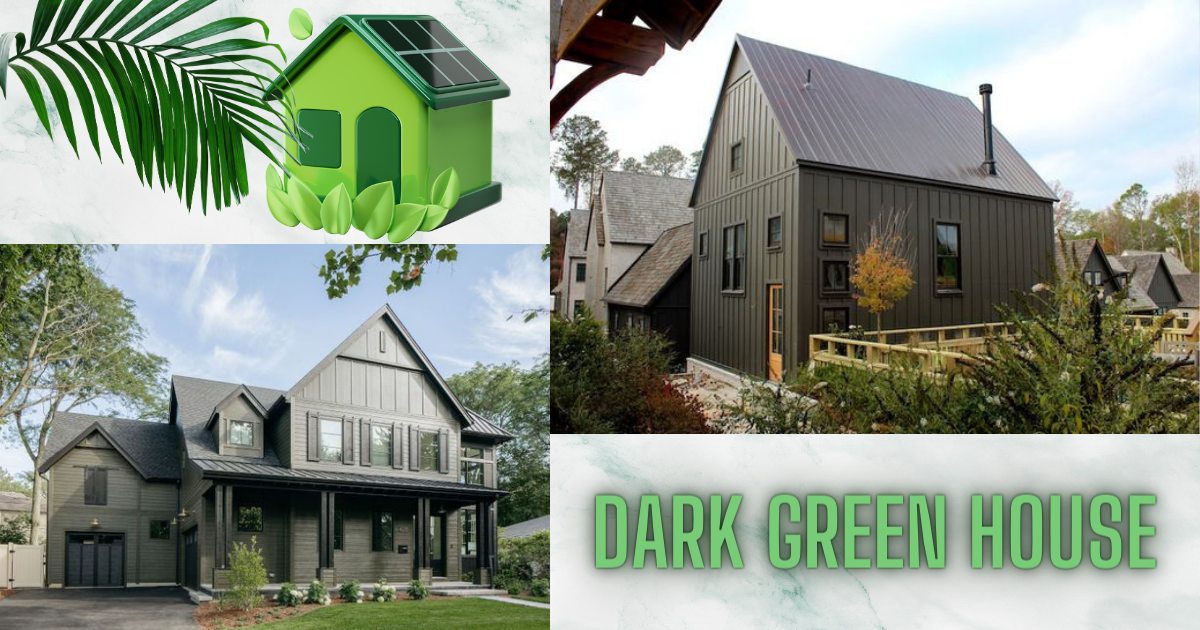
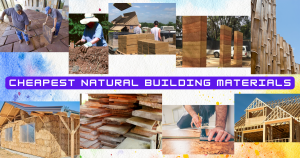
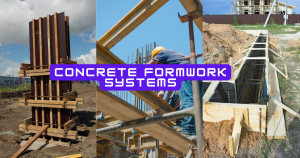
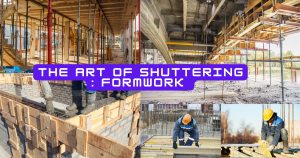
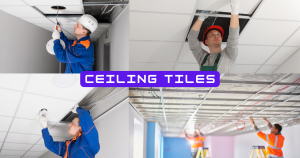
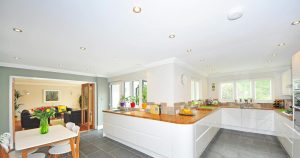

1 thought on “The Rise Of Dark Green House : Embracing Sustainability”